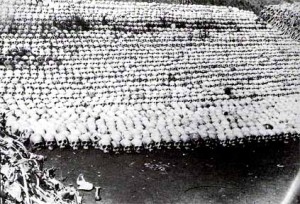On this day in 1975, Pol Pot’s Khmer Rouge captured Cambodia’s capital Phnom Penh and declared revolutionary Year Zero. After five years of bloody civil war, the conquering Communist guerrillas were welcomed as heroes by a relieved population desperate for peace – but the relief was to be short-lived. Within twenty-four hours, members of the deposed Lon Nol government, public servants, police, military officers, ethnic Vietnamese, Christian clergy, Muslim leaders and middle-class citizens were identified and executed. Schoolteachers, students, doctors and those who simply wore glasses or knew how to read were murdered for being “intellectuals”. Foreigners were expelled, embassies closed and the currency abolished. Markets, schools, newspapers, religious practices and private property were forbidden. The Khmer Rouge then set about evacuating the entire city of Phnom Penh: schools, hospitals, factories, offices and homes were raided at gunpoint and their occupants force-marched into the countryside. Soon, the country’s entire population was forced to relocate to the agricultural labour camps, the so-called “killing fields”, as part of Pol Pot’s master plan to transform the renamed Democratic Kampuchea into a self-sufficient Maoist agrarian state. And so began Pol Pot’s reign of terror – one of the most evil and brutal regimes of the twentieth century. In just three years and eight months, an estimated 3 million Cambodians would be annihilated by bullet, axe, shovel blow to the back of the head, plastic bag suffocation, unspeakable torture, or by starvation – the auto-genocidal victims of Pol Pot’s ruthless bid to “purify” Cambodia.
But lest we forget that U.S. military action against Cambodia was probably the single most significant factor in Pol Pot’s rise from leader of a small sectarian group with no popular base to tyrannical despot. Between 1969 and 1973, American B-52s dropped 2,756,941 tons’ worth of explosives in 230,516 sorties on 113,716 sites – more than was dropped by all parties in World War II. The secret and illegal bombing of then-neutral Cambodia by Richard Nixon and Henry Kissinger caused such widespread death and devastation that it drove recruits directly to Pol Pot. “[The Khmer Rouge] are using damage caused by B-52 strikes as the main theme of their propaganda,” the CIA director of operations reported on 2 May 1973. “This approach has resulted in the successful recruitment of young men.” New York Times correspondent Sydney Schanberg confirmed that the Khmer Rouge “… would point… at the bombs falling from B-52s as something they had to oppose if they were going to have freedom. And it became a recruiting tool until they grew to a fierce, indefatigable guerrilla army.” In dropping the equivalent of five Hiroshimas on a peasant society, Nixon and Kissinger killed an estimated half-a-million innocent people and verily ushered in Year Zero.
America’s Cambodian guilt does not end there. In the face of mounting evidence of Pol Pot’s atrocities, the U.S. government – still reeling from its Vietnam debacle – was suddenly not so very eager to stick its nose into Southeast Asia’s business. Unbelievably, the Khmer Rouge even enjoyed support from the United States because of its opposition to Vietnam. While the self-styled World Police ignored the Cambodian Genocide despite its obligation under the terms of the 1948 Geneva Convention, it was left to their old Vietnamese enemy to eventually overthrow Pol Pot’s murderous regime.
Oh the hypocrisy of selective American democracy.



Pingback: Are guns on campus OK? Ask the students and cops on northshore | The Lens